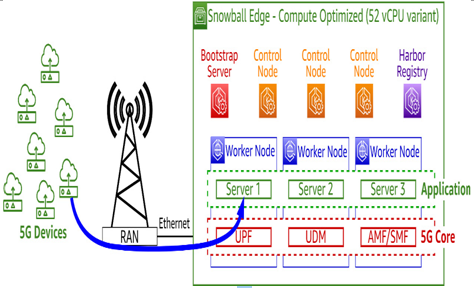Using AWS Snowball Edge to host a private 5G core – Architecting for Disconnected Edge Computing Scenarios
The following figure demonstrates a typical architecture for a mobile 5G core. A containerized NFV partner solution is installed into EKS-A, which, in turn, is deployed onto a single AWS Snowball Edge device. The RAN provided by the partner ISV in this particular case includes the RAN functions plus the RF equipment in a single piece of hardware:

Figure 9.20 – Mobile 5G core on AWS Snowball Edge
This architecture is not uncommon in such circumstances as it simplifies the management of the 5G core in the sense that you always know that all components are on this one device. However, this lack of redundancy sacrifices resilience at the physical layer. It also services a limited number of 5G devices.
You could expect this smaller variant of the compute-optimized AWS Snowball Edge to support the base EKS-A components, a small 5G core, and a small user-built application. In turn, this small 5G core would probably support ~100 5G devices registered on the RAN. However, the aggregate throughput between them and the application servers will be constrained by the Ethernet port(s) used on the AWS Snowball Edge device, and the applications they are communicating with. In other words, you would probably not expect all 100 devices to be able to push 1 Gbps to the application simultaneously, even if the devices individually could do so.
Summary
In this chapter, we explored various scenarios involving DDIL settings. Initially, we presented an overview of these conditions, describing the challenges that are encountered under DDIL conditions.
Next, we addressed the utilization of AWS IoT services in DDIL contexts. We examined how AWS Snowcone operates as an efficient IoT gateway that facilitates data processing and storage in edge locations and reaches back to AWS over the Inmarsat BGAN SATCOM network. Moreover, we gave an overview of AWS IoT Greengrass, illustrating how it integrates with other AWS services to provide a cohesive solution in limited connectivity areas.
Following that, we moved on to the tactical edge segment, focusing on the deployment strategies involving the AWS Snow family and AWS Outposts. We described the benefits of integrating EKS-A with both AWS Snowball Edge and bare-metal servers, providing a resilient and rugged solution. Then, we discussed AWS MDC and how it hosts AWS Outposts in forward-deployed locations, enabling seamless operations in such environments.
Lastly, we turned our attention to the intersection of private 5G networks and DDIL scenarios. Here, we highlighted how EKS-A and AWS Snowball Edge combine with partner ISV solutions to build a private 5G core. This allows customers to quickly deploy isolated 5G networks to support communication with devices under circumstances where Wi-Fi will not suffice.
In the next chapter, we will take a look at how customers are combining AWS Wavelength with other AWS services to build Multi-Access Edge Computing (MEC) solutions.